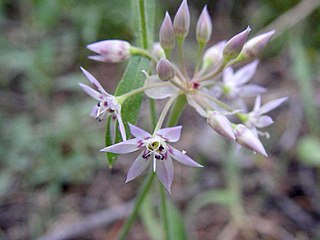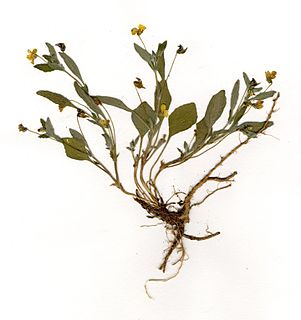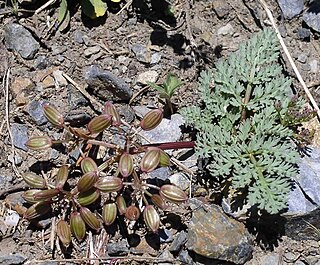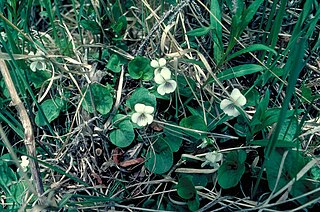Iris albertii is a species of iris found in Central Asia. It grows in the wild on grassy steppes at an elevation of 200 to 2000 meters, in sunny or semi-shaded locations. It is a member of the subgenus iris, meaning that it is a bearded iris, and grows from a rhizome.

Viola beckwithii, known commonly as the Great Basin violet, Beckwith's violet, and sagebrush pansy, is a species of violet native to the western United States. It is an early-flowering plant of sagebrush habitats in the Great Basin region.

Viola purpurea is a species of violet which bears yellow flowers. It is known commonly as the goosefoot violet. It is a small plant which bears thick to fleshy toothed or ridged oval leaves which are mostly green but may have a purplish tint to them. The flowers are made up of bright yellow petals, the lowermost being streaked or veined with purple and the lateral petals with purplish undersides.

Allium campanulatum is a species of wild onion known by the common name dusky onion or Sierra onion. This is a flowering plant native to the western United States from southeastern Washington and northern Oregon to southern California, and western Nevada. The dusky onion grows in foothills and mountains, especially in dry areas, such as chaparral habitats.
Guillenia flavescens is a species of mustard plant known by the common name yellow mustard, but it is not the only species known by that name. Sinapis alba is probably the plant more widely known as yellow mustard. G. flavescens is a thin-stemmed annual herb growing large, lobed or toothed leaves up to 22 centimeters long around its base, and smaller, less toothed leaves along its gray-pink to brown stem. At intervals along the upper stem appear cream, yellowish, or very pale purple flowers, each somewhat cuboid in shape and about a centimeter long. The tips of the petals around the mouth are curled, flared, or clawlike. The fruit is a thin silique up to 9 centimeters long. This species is endemic to California, where it grows in the valleys and mountains surrounding the San Francisco Bay Area.
Keckiella rothrockii is a species of flowering plant in the plantain family known by the common name Rothrock's keckiella. It is native to the desert mountains of southeastern California and adjacent Nevada, where it lives in sagebrush and woodland. This is a short, wide shrub reaching maximum heights near half a meter. The hairy green stems bear small oval-shaped leaves up to 1.5 centimeters long. The flowers vary in color from brownish to yellow to cream, and are sometimes striped with dull purple or brown. Each is up to about 2 centimeters long with curling lobes at the mouth. Inside the tubular flower are stamens, including a flat, sterile stamen known as a staminode.

Allium praecox is a species of wild onion known by the common name early onion.

Chenopodium atrovirens is a species of flowering plant in the amaranth family known by the common names pinyon goosefoot and dark goosefoot.
Chorizanthe palmeri is a species of flowering plant in the buckwheat family known by the common name Palmer's spineflower. It is endemic to California, where it is known only from the Central Coast Ranges of western Monterey and San Luis Obispo Counties.

Lomatium mohavense is a species of flowering plant in the carrot family known by the common name Mojave desertparsley. It is native to southern California with a few outlying populations in Arizona, Nevada and Baja California. It is found in several types of mountain and desert habitat, including chaparral, woodland, and scrub, mostly from 2,000–7,000 feet (600–2,100 m) elevation.

Streptanthus tortuosus is a biennial or short lived perennial plant in the mustard family (Brassicaceae) known by the common names shieldplant, shieldleaf, and mountain jewelflower.
Viola aurea is a species of violet known by the common names golden violet and bright yellow violet. It is native to eastern California and western Nevada, where it is known from scattered occurrences in various types of dry habitat such as the slopes of desert mountains. This herb grows from a tough taproot and produces a woolly-haired stem up to about 13 centimeters tall. The leaves have toothed or wrinkled, rounded or oval blades borne on petioles. They are coated in thick, white hairs. A solitary flower is borne on an upright stem. It has five yellow petals, the lowest one marked with brown veining and the upper pair tinged with brown or purple on the outer surface.

Viola bakeri is a species of violet known by the common name Baker's violet. It is native to the Western United States, from Washington and Oregon, to the mountains of northern Nevada, and in California to the southern High Sierra Nevada.

Viola lobata is a species of violet known by the common name pine violet. It is native to western North America from southern Oregon through California and into northern Baja California, where it occurs in mountain ranges and foothills. It grows in woodlands and other habitat. This rhizomatous herb produces an erect stem a few centimeters tall or growing to nearly half a meter in maximum height. The leaves have variously shaped blades borne on long petioles. The blades are 5 to 15 centimeters wide and may be hairless, hairy, or waxy in texture. The leaf blades are often divided into narrow lobes or dissected into small segments. The shape of the leaf blade differentiates the two subspecies; ssp. lobata has dissected leaves and ssp. integrifolia has entire or toothed blades. A solitary flower is borne on a long, upright stem. It has five yellow petals, all five or just the lower three with purple or brown veining and the upper two stained with purple or brown on the outer surfaces.

Viola ocellata is a species of violet known by the common names pinto violet, two-eyed violet, and western heart's ease. It is native to southern Oregon and northern and central California, where it occurs in the coastal foothills and mountain ranges. It sometimes grows in serpentine soils and in quicksilver mines.

Viola praemorsa is a species of violet known by the common names canary violet, Astoria violet, and yellow montane violet.

Viola tomentosa is a species of violet known by the common names feltleaf violet and woolly violet. It is endemic to the central Sierra Nevada of California, where it occurs in various types of dry mountain forest habitat. This small herb grows from a deep taproot, reaching a maximum height of 5 to 10 centimeters. The herbage is coated with woolly hairs. The leaves have oval blades borne on petioles a few centimeters long. A solitary flower is borne on a short upright stem. It is under a centimeter long with five yellow petals. The lower three petals are veined with dark brown and the upper two are stained brown or purplish on the back sides.

Lomatium erythrocarpum, known by the common name redfruit desertparsley, is a rare species of flowering plant in the carrot family. It is endemic to Oregon in the United States, where it is limited to a section of the Blue Mountains within Baker County.

Viola renifolia is a species of violet known by the common names white violet and kidneyleaf violet. It is native to northern North America, where it has a widespread distribution across Canada and the northern United States as far south as Washington, Colorado, and New York.














